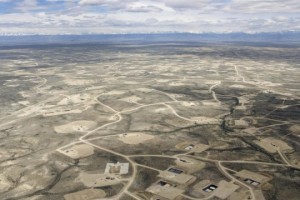TITLE: Oil and gas development transforms landscapes
From a Report by Brady Allred, et al., The University of Montana, April 29, 2015
Researchers have conducted the first-ever broad-scale scientific assessment of how oil and gas development transforms landscapes across the US and Canada. A landscape transformed by broad-scale vegetation loss and fragmentation from oil and gas development is shown in the photo.
But what are the ecological consequences of this accelerated drilling activity? Researchers at the University of Montana have conducted the first-ever broad-scale scientific assessment of how oil and gas development transforms landscapes across the U.S. and Canada.
Their work was published April 24 in an article titled “Ecosystem services lost to oil and gas in North America” in Science. The article concludes that oil and gas development creates significant vegetation loss of rangelands and croplands across broad swaths of central North America.
Lead author Brady Allred said, “There are two important things here: First, we examine all of central North America, from the south coast of Texas to northern Alberta. When we look at this continental scale picture, we see impacts and degradation that are missed when focusing only at a local scale. Second, we see how present policies may potentially compromise future ecosystem integrity over vast areas.”
Allred and co-authors estimated that from 2000 to 2012 oil and gas development removed large amounts of rangeland vegetation, culminating at a rate per year of more than half of the annual grazing on U.S. public lands. Vegetation removed by this development on croplands is equivalent to 120.2 million bushels of wheat, approximately 13 percent of all wheat exported by the U.S. in 2013.
Fragmentation and loss of habitat also disrupts wildlife migration routes, alters wildlife behavior and assists new disruptive invasive plant species. Co-author Dave Naugle highlights the complexity of the issue: “We’ve known about the impacts of oil and gas development for years, but we now have scientific data from a broad regional scale that tells us we need to act now to balance these competing land uses.”
Furthermore, nearly half of wells drilled are in extreme- or high-water-stress regions. High-volume hydraulic fracturing uses 2 million to 13 million gallons of water per well, intensifying competition among agriculture, aquatic ecosystems and municipalities for water resources.
“We need a policy framework that quantifies and weighs major tradeoffs at large scales because current policy does not address both assessment and future mitigation adequately,” said co-author Julia Haggerty of Montana State University.
“Satellite technologies now can provide annual acre-by-acre information for land managers on oil-and-gas-driven land-use changes,” said Steve Running, a co-author and UM Regents Professor of Ecology. “We must have policies that ensure reclamation of this land after production has ended. Otherwise, by 2050, tens of millions of acres of land will be permanently degraded.”
The authors assessed the ecosystem services lost by using high-resolution satellite measurements of vegetation growth based on methods developed by co-author W. Kolby Smith and previous groundbreaking research by Running. Terrestrial plant production is the foundation of the biospheric carbon cycle and the basis for a multitude of critical ecosystem services.
>>> Brady Allred is assistant professor of rangeland ecology at UM’s College of Forestry and Conservation. Additional co-authors are W. Kolby Smith, a recent UM doctoral student now at the Institute on the Environment at the University of Minnesota; Dirac Twidwell from the University of Nebraska-Lincoln; and Samuel Fuhlendorf from Oklahoma State University <<<
See also: www.FrackCheckWV.net

